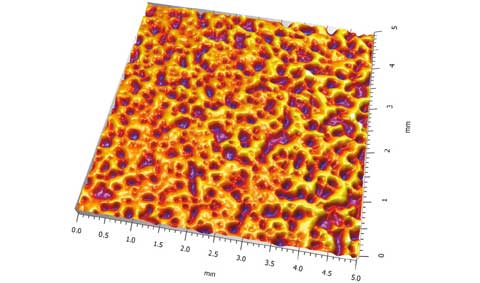R&W motifs (ISO 12085) have been widely used for over 40 years, mainly in France. Now part of an improved method using watershed segmentation, they are soon to be included in the revision of profile standards (ISO 21290). Following his paper on the subject at the recent Met & Props 2019 conference*, François Blateyron, Digital Surf’s surface metrology expert explains.

R&W motifs method reborn
The watershed segmentation method, applied to surfaces, is becoming increasingly successful thanks to its ability to automatically identify structures and texture cells on surfaces, called “motifs”. The resulting motifs can be considered as “significant” due to a discrimination method, called “Wolf-pruning” which reduces oversegmentation and merges non-significant motifs with larger adjacent ones, by using a threshold based on a percentage of the total height Sz.
The threshold is compared to the height between the highest saddle point and the peak in the case of a hill (or between the pit and the lowest saddle point in the case of a dale). Feature parameters described in ISO 25178-2 allow the characterization of these significant motifs, and they can be used in the tolerancing of many modern surfaces that contain periodical or identified structures.
Profile segmentation
Watershed segmentation can also be applied on profiles, in a simplified form, to identify profile motifs. It is thus being considered as a candidate for replacing the old R&W motifs method (ISO 12085:1996) that was built on a complex algorithm with many special cases. The new method is expected to stabilize motif detection and provide compatible parameters. The profile watershed segmentation is described in ISO/WD 16610-45 and the associated parameters are included ISO/ CD 21920-2, both in development.
It is important to ensure continuity and compatibility with the former method so that users can update their drawings and tolerances to the new method without too many changes. Therefore, it is important to compare parameter values given by these two methods and define adequate default values.
Domain of application
The method identifies motifs made of a succession of peak-pit-peak triplets. Motifs identify tool marks on a machined surface and make it possible to identify height and width of this machining signature, in order to verify process settings and compliance. It is assumed that the measured profile exhibits motifs-like features. Usually, machining methods that leave a periodical or semi-periodical texture signature, such as turning or grinding, can easily be verified using the motifs method.
The main parameters of ISO 12085 are R (mean height of motifs) and AR (mean width of motifs). When these parameters are calculated on a profile with clearly identified motifs, the mean value is significant and associated with a small standard deviation. Interestingly, the original CNOMO method defined SR and SAR parameters as the standard deviation for R and AR, but the publication in an ISO standard saw the loss of these important parameters.


Top. Motifs on a profile with periodical marks. Mean height R and mean width AR are significant.
Bottom. Motifs on a irregular profile. R and AR are just a statistical mean of small and large motifs averaged together.
What do we get if we calculate these parameters on irregular or stochastic profiles? Well, we can always calculate a mean value, but we average narrow and wide-motif widths, short and tall-motif heights etc. Moreover, motifs are unstable when reversing or shifting the profile. Some say that the method is inherently not stable, but the truth is that it should be used only on profiles that exhibit a minimum of texture motifs, i.e. periodical or semi-periodical profiles. And unfortunately, the practice is not in line with that principle; many users continue to calculate R and AR on irregular profiles, instead of using classic Rq, Rsk parameters etc. which are better suited to irregular profiles. This observation also applies to RSm and Rc from ISO 4287 that are associated with a segmentation method too.
Default values
ISO 12085 uses a limit A to separate roughness from waviness motifs. But it also controls the segmentation itself. Its default value of 0,5mm for a profile length of 16mm is usually used as-is without any question. But the reality shows that a better value can often be found if we consider that the motif segmentation should detect regular motifs with the smallest standard deviation. The simple ratio AR/SAR can be calculated, and if a profile is periodical, the standard deviation will be small compared to the mean and the ratio will be high. On the contrary, the ratio will be small on irregular profiles. This can be used to test several values for the limit A in order to define the “optimal limit A”, i.e. the one with the highest value for the ratio AR/SAR.

Above. The graph of AR/SAR values is split in two categories with a threshold = 2,0 which means that the standard deviation is not higher than 50% of the mean value. The 57 green profiles on the left can be considered as suitable for the motifs method. A finer selection can be obtained with a combination of R/SR and AR/SAR ratios.
Comparisons
The comparison of values on R and AR between the old method (with optimal limit A) and the watershed segmentation, with an adequate pruning shows very good correlation which means that the new method is a safe replacement, when used with the correct settings.


Above. Comparison of the ISO 12085 (optimal A) and watershed methods shows good correlation
Further work
More investigations must be done in order to adjust the method and answer any remaining questions. For example, the upper envelope used to calculate waviness parameters in ISO 12085 can be replaced by a morphological closing filter using a disc as a structuring element. But with what radius? Another unsolved question relates to the removal of deep valleys or high peaks, which was done in the old method using a threshold on motifs height when exceeding 1,65σ of the height distribution. With the watershed segmentation, a simpler statistical method could be used. This work will then help to define adequate default values in the new ISO standards and define good practice. Segmentation of motifs on profiles is still a useful method. Watershed segmentation, together with a pruning and adequate configuration make it possible to solve the stability problems of ISO 12085 but keep the benefit of 40 years of experience in qualifying mechanical components.
* Paper co-authored with Bertrand Leroy, Peugeot-Citroën SA
You may also be interested in:
Does it make sense to compare Ra and Sa values?

Author : François Blateyron
Resources :
ISO 12085:1996 GPS – Profile method – Motifs parameters
ISO/WD 16610-45 – Filtration – Profile morphological: Segmentation
ISO/CD 21920-2 – Surface texture: Profile – Terms, definitions and surface texture parameters
Blateyron F, Adam M (2004), Application of image segmentation to motifs evaluation on 2D profiles, Proc. XI Colloq. Surfaces, Chemnitz, 56-64.